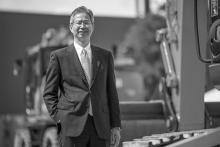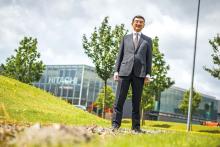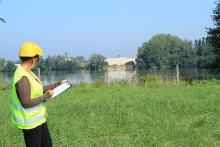
Hitachi Construction Machinery (Europe) NV (HCME) has a longstanding ambition to become Europe’s biggest construction and quarrying equipment manufacturer. The desire to be first is reflected in the three priorites identified by HCME president and management board chairman, Makoto Yamazawa, since he took on his senior roles in April 2016. Guy Woodford reports.
Today’s quarrying and construction equipment marketplace is very different in its make-up to the one before the 2008 global financial crisis. No longer are model unit sales the undisputed king of the sector. It’s this shift and how to benefit from it that has dominated Makoto Yamazawa’s first year as HCME president. And he’s wasted no time in putting his vision into action.
“For the first time, our number one priorities are servicing, parts replacement and machine durability,” he explains. “Our efforts have traditionally gone into expanding our market share. However, the competition has become very tough. This is partly due to cost increases to meet new engine emission regulations coming into place. It’s not easy to transfer this to the marketplace, so we can’t gain as much profitability from machine sales. I think all manufacturers are facing the same issues we are. Where there is a great deal of potential is in the model life cycle business. Many of our customers are buying parts from various aftermarket sources, so we are looking very carefully at our parts pricing strategy and trying to have closer tie-ins with local European suppliers. Globally, at the same time,
Yamazawa says the profitability coming out of parts sales is “extremely” different from machine sales. “We are looking to the aftersales market very much to sustain our overall business. This should also bring key benefits to the customer in terms of accessing more genuine quality replacement parts, ensuring longer model uptime.”
Speaking to Aggregates Business Europe during HCME’s November 2016 Press Event at the company’s European HQ in Amsterdam, Yamazawa said the manufacturer had just had a near-all European dealer meeting focused, for the first time, on machine model parts and servicing. “We shared a lot of information with the dealers and made them aware of how quality parts and servicing can benefit their businesses. We will have new incentive programmes [from March 2017] that are more focused on parts and servicing and will be having follow-up meetings and visits to dealers by HCME management. Crucially, we want our dealers to have more and more contact with our customers.”
Of the third priority focus on the durability of Hitachi’s excavators and wheeled loaders, Yamazawa said: “Many customers cannot afford to replace equipment over a short period of time, and its durability can significantly lower fleet life cycle costs. This thinking has been applied to all our new Zaxis-6 models. That’s why we talk about ‘No Compromise’ when we highlight the development of this range. When customers touch and try our latest earthmovers, they can see and feel the durability of the undercarriages, frames, parts and front attachments.”
Yamazawa is also excited about how Hitachi is looking to enhance its on-board telematics offering to reduce customer earthmover fleet operation costs. “In Japan, Hitachi is carrying out work at the newly-opened ICT Demonstration Centre at Hitachinaka, Ibaraki Prefecture, where customers can see demonstrations of what we can do in telematics. New telematics for our European market earthmovers are coming from fiscal year 2017-2018. Retrofits, of course, will be possible.
“One important thing for customers is that they are lacking skilful operators. With machine telematics, you can precisely dig a hole at the required angle. With the new Hitachi telematics solution, customers will be able to remotely monitor the usage of each component on an excavator or wheeled loader. This will enable them to see in more detail how heavily the machine is being used, rather than just relying on working hours. Some machines may have been working for 5,000 hours but their components are not so fatigued. Their working life can be extended much longer.”
Another important telematics facet, says Yamazawa, is to have an alert system to make business owners, model operators and dealers aware of accidents or major machine defects. “This means everyone can quickly share what’s going on with the machines, and spare parts can be immediately prepared and engineers dispatched to carry out servicing,” he explains. “Hitachi is looking at some kind of SMS messaging facility or App service covering this area.”
The HCME Press Event 2016 saw a large gathering of the world’s quarrying and construction trade press shown Hitachi’s full range of new Zaxis-6 range of crawler excavators, including two new large excavators, the ZX690LCH-6 and ZX890LCH-6, for quarries and large construction sites, and five new medium excavators, from the ZX130-6 to the ZX210LC-6. Also introduced were the new ZX240LCN-6, with a narrow undercarriage making it easier to transport on smaller roads, and the short-tail swing models, ZX135US-6 and ZX225USLC/USRLC-6, said to be ideal for working in confined spaces.
Hitachi has also launched four new Zaxis-6 wheeled excavators, including the new short-tail swing model, ZX145W-6. These machines are said to have been designed with more than 100 updates, from tiny seals and O-rings to the reinforcement of the upper structure, boom and arm, and new Stage IV technology engines. All this is said to lead to better model performance and increased efficiency.
The latest ZW-6 wheeled loader to be presented during the Press Event was the ZW180-6. It has been designed to provide exceptional all-round visibility, with its repositioned exhaust pipe and curved engine hood, and with a standard rear-view camera and monitor. Easy to use and smooth to operate, it offers a high level of comfort and is said by HCME to be one of the quietest on the market.
Yamazawa stresses how increasing HCME’s share of the European wheeled loaders market is another key target for him and his executive team. “We at Hitachi are famous for our excavators. Our market presence is there – including being quite strong in excavators for the quarrying business. For years, we’ve been trying to build our wheeled loaders’ profile. Europe has the second or third largest market for wheeled loaders – after the United States and China. Increasing our wheeled loader presence here in Europe would definitely contribute to our market presence globally.
“The two biggest players in Europe for wheeled loaders are
Since taking up his senior HCME roles, Yamazawa says he has also been working a great deal on the company’s supply chain management and production efficiencies. “This includes how we can reduce our model assembly costs, the costs around our logistics, and reducing customer model lead time. This will bring us joint benefits of running less inventory and providing better services to our dealers.
“We’ve got one factory in Amsterdam for mid-sized excavators and wheeled loaders’ assembly. And another factory in Oosterhout [south Netherlands], close to the Belgian border, for mini excavators and special application machines. We’re coming up with a plan to optimise these two sites. Maybe some of the components could be shared or we could switch the production base and change the way we assemble. The two Dutch factories are more for modifications whereas the mother factory in Japan is focused on mass production of standardised models. By doing this, value can be leveraged, such as in reducing customer lead time.”
Yamazawa has a long and impressive history with Hitachi Construction Machinery (HCM) – and it’s evident that the diversity of his previous company roles and knowledge gained from them are reflected in his approach to his dual role at HCME.
After graduating in law from Waseda University in Tokyo, he joined HCM in 1983 as a sales representative for the company’s domestic business. Eight years later, he was transferred to HCM’s International Division for ten months before a subsequent transfer to the company’s subsidiary in Thailand.
Yamazawa held the positions of marketing and sales manager in Bangkok from 1992 until 1998, and managing director of HCM’s Malaysian subsidiary from 2005 to 2010. In between these posts, he took up various managerial roles at the Tokyo head office within the Asia and Oceania (1998-2000), Mining (2000-02, 2004-05 and 2010-16) and Construction (2002-04) departments.
Describing his management style as “very flexible”, Yamazawa is not a micro manager and says he has empowered his HCME country sales and product engineering heads. “On a day-to-day basis, I rely on them. I also do not want to change good localised management. There are many cases where a new president comes and wants to change everything and you have to start from scratch. I do not want that here. What I do want is for the decision-making process to be more speedy. That’s why we’ve changed our organisation to make it easier to contact dealership heads for each European country.”
Turning his attention to the European marketplace, Yamazawa said: “It’s quite stable and is growing a little bit in some countries. Germany, France and UK remain the strongest trading markets,” continues Yamazawa. “Our dealership in the UK, in particular, is doing a good job and hit record first half year sales in 2016, while also increasing our market share. They’ve been doing a lot of work with rental companies and have expanded sales to them, especially sales of mini excavators and larger wheeled loaders.
“I still see a great deal of potential in Europe, including in infrastructure building activities. Our base here in the Netherlands is where we started our overseas operations back in 1972. We’ve been distributing our equipment from here since then and our machine population is reasonably high.”
Yamazawa is, like all senior figures at leading OEMs, waiting to see the full impact on the European construction, quarrying and mining industries of the UK’s June 2016 referendum vote to leave the European Union. Given Europe’s close trading links with the United States, Yamazawa is also keeping a close eye on President Donald Trump’s first few months in the White House.
If another major economic downturn comes, Yamazawa says HCME must be in a position to cope with this. “My ultimate goal is to make this company sustainable. The market situation is beyond my control. There may be another Brexit or Lehman Bros. shock. To make this company sustainable, I must make it healthy. I’m very sure our business model can help us achieve this goal.”








